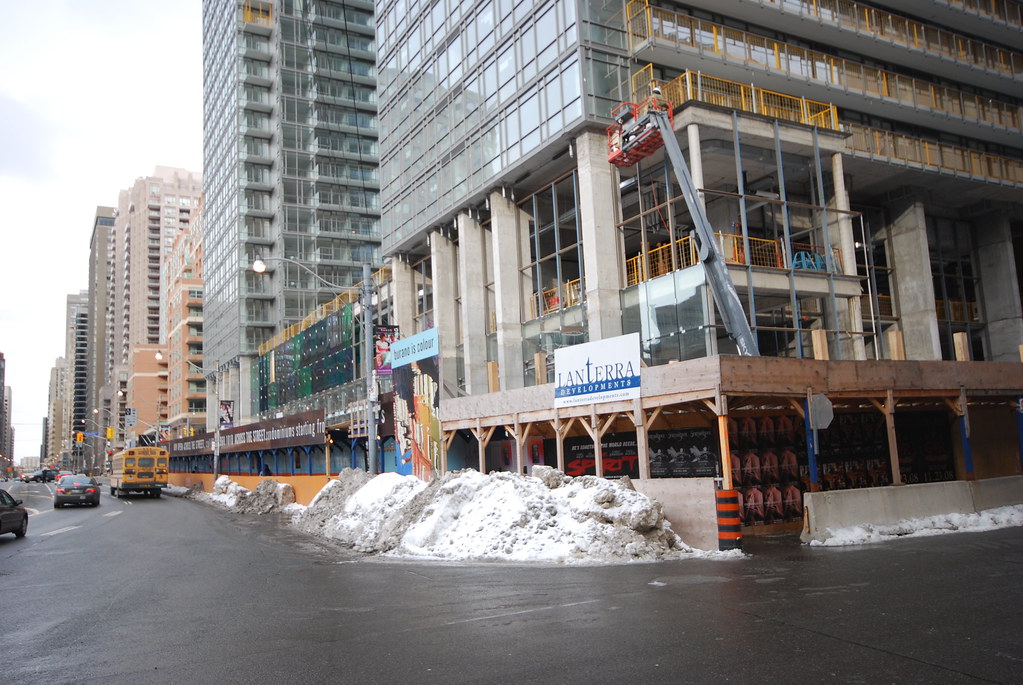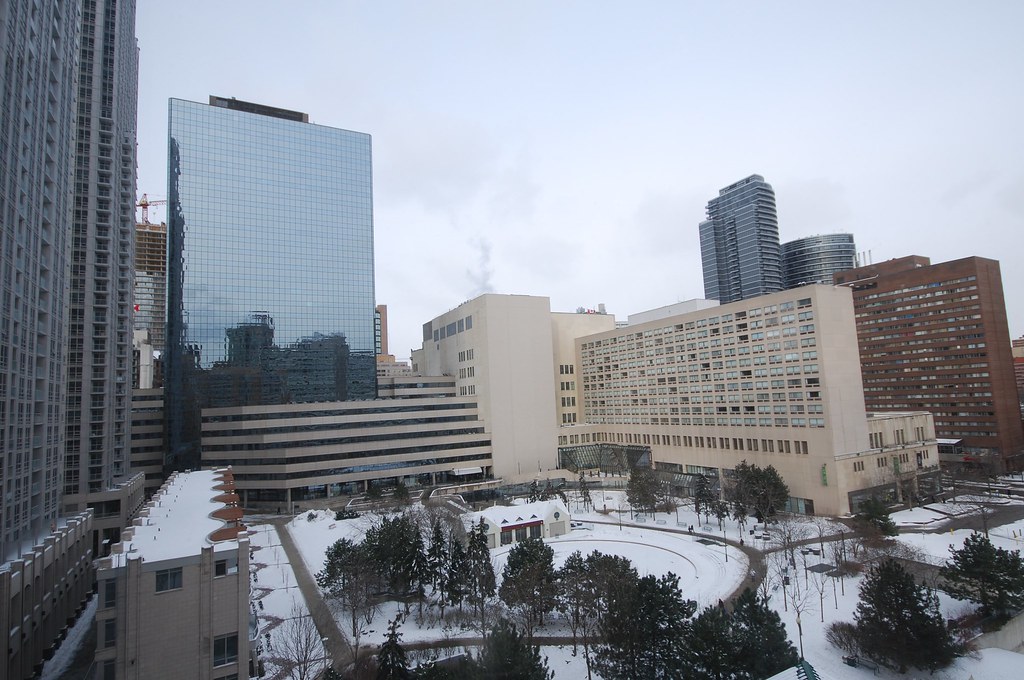I doubt the condo has any connection to the retail $$$. The retail units are usually a separate entity either held by the developer or sold to a company that specializes in retail management.
You are using an out of date browser. It may not display this or other websites correctly.
You should upgrade or use an alternative browser.
You should upgrade or use an alternative browser.
Archivist
Senior Member
I looked at lunch today and it was a bit hard to tell, though certainly it does seems that no doorways are being built in. I saw one thing on Bay Street that looked as if it could mutate into an egress, but time prohibited me from being thorough.
If there aren't more entrances onto the Bay Street side, then I agree that it is unfortunate. I wonder what the difference is between North York condos (many of which have many small retail fronts) and downtown condos (which frequently have limited or very large retail with few entrances).
If there aren't more entrances onto the Bay Street side, then I agree that it is unfortunate. I wonder what the difference is between North York condos (many of which have many small retail fronts) and downtown condos (which frequently have limited or very large retail with few entrances).
confusion
Active Member
I doubt the condo has any connection to the retail $$$. The retail units are usually a separate entity either held by the developer or sold to a company that specializes in retail management.
I guess it all depends on the condo purchased the extra units then. I know for a fact that my condo owns the retail at street level. I know this because the rent money shows up on my annual financial statement which I just got for this year. I assumed this was the way it was for most.
DSC
Superstar
I guess it all depends on the condo purchased the extra units then. I know for a fact that my condo owns the retail at street level. I know this because the rent money shows up on my annual financial statement which I just got for this year. I assumed this was the way it was for most.
I think there is great variation, in our condo building the "commercial unit' is a separate "unit" in the Declaration and is owned by a person - who has subdivided it and sub-lets to 4 or 5 small stores. The owner pays a % of the condo fees just like the owners of the residential units.
Tewder
Senior Member
If there aren't more entrances onto the Bay Street side, then I agree that it is unfortunate. I wonder what the difference is between North York condos (many of which have many small retail fronts) and downtown condos (which frequently have limited or very large retail with few entrances).
Interesting point. I'm not so sure it's a bad thing per se. Toronto is big enough to accommodate thoroughfares that have distinctly different characters/land usage. Yonge can be almost completely retail/commercial whereas Bay can be largely residential (north of Queen at least). In North York this is less feasible and Yonge Street being the main central artery serves many different purposes. Aside from local conveniences (corner stores, banks and dry cleaners etc) I think it is probably much better that retail clusters form together where there is power in numbers (foot traffic, exposure, ease of accessibility, business improvement initiatives etc)
Hypnotoad
Senior Member
Some standard Murano pictures:



Full size, Burano in the foreground:


And finally, something new, a view of College Park with Murano in the distance:




Full size, Burano in the foreground:


And finally, something new, a view of College Park with Murano in the distance:

smuncky
Senior Member
wow! great shots!
SP!RE
°°°°°°
Excellent photos!
It's so strange to see Murano in existence, physically, before my own eyes on a regular basis, when it was a good number of years ago now that it was in advertising/sales and I was a high schooler dreaming of being in Toronto with buildings like that going up around me.
I like how the coloured glass portion seems to "float" above the normal glass of the podium below it.
It's so strange to see Murano in existence, physically, before my own eyes on a regular basis, when it was a good number of years ago now that it was in advertising/sales and I was a high schooler dreaming of being in Toronto with buildings like that going up around me.
I like how the coloured glass portion seems to "float" above the normal glass of the podium below it.
I guess it all depends on the condo purchased the extra units then. I know for a fact that my condo owns the retail at street level. I know this because the rent money shows up on my annual financial statement which I just got for this year. I assumed this was the way it was for most.
Interesting. In my building we have nothing to do with the retail.
egotrippin
Senior Member
This building is turning out wonderfully so far. However I'm curious, are those silver things between the art glass panes permanent? I really hope they're temporary during the installation, because as it is, they really detract from the overall effect.
MisterF
Senior Member
Every building should be designed to be pedestrian friendly and interesting to walk past. More often than not that means small scale design at street level and multiple doorways to provide interaction, whether they're retail, residential or otherwise. Blank walls rarely achieve that goal. Segregating land uses (retail/commercial on Yonge, residential on Bay) is generally frowned upon in planning circles, especially downtown. There's nothing wrong with the retail on Bay being primarily neighbourhood-focused. That's for the market to decide.Interesting point. I'm not so sure it's a bad thing per se. Toronto is big enough to accommodate thoroughfares that have distinctly different characters/land usage. Yonge can be almost completely retail/commercial whereas Bay can be largely residential (north of Queen at least). In North York this is less feasible and Yonge Street being the main central artery serves many different purposes. Aside from local conveniences (corner stores, banks and dry cleaners etc) I think it is probably much better that retail clusters form together where there is power in numbers (foot traffic, exposure, ease of accessibility, business improvement initiatives etc)
Probably best to wait until we see what the street level is like in this building.
SP!RE
°°°°°°
This building is turning out wonderfully so far. However I'm curious, are those silver things between the art glass panes permanent? I really hope they're temporary during the installation, because as it is, they really detract from the overall effect.
Those are little buffers that hold the glass panels in place.
Mullions will be placed along all the "lines" between windows, creating an effect similar to the tower portion.
egotrippin
Senior Member
Ah, ok that's good to know. I've never noticed the buffers visible in any other projects before (from memory) so I was worried for a second.
whatever
Senior Member
Actually, those are dutchmen, and they're temporarily pressing the glass into the caulking while it cures. Once the caulking cures they're removed and the butt joints will be caulked with a finished show bead (probably black, I would imagine).
If there was a finished snap cap trim being installed they would've just installed pressure pads and done the trim at the same time, instead of using the temps.
And the mullions have already been installed, it would basically be impossible to have the glass there without them.
If there was a finished snap cap trim being installed they would've just installed pressure pads and done the trim at the same time, instead of using the temps.
And the mullions have already been installed, it would basically be impossible to have the glass there without them.
SP!RE
°°°°°°
I was just trying to describe it so he could understand it.
"Mullions" is the word I used to explain metal strips over top of the gaps where windows meet.
"Mullions" is the word I used to explain metal strips over top of the gaps where windows meet.